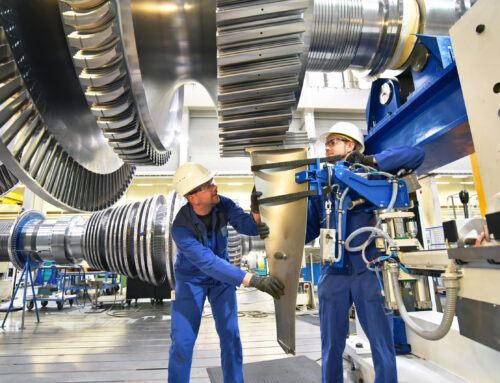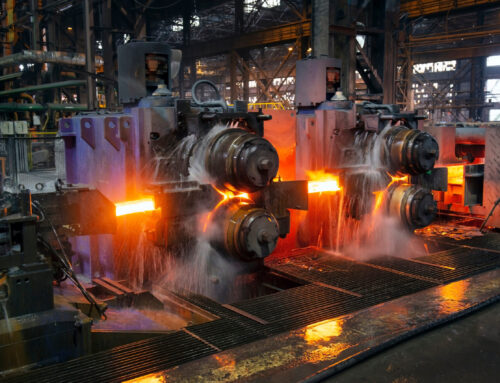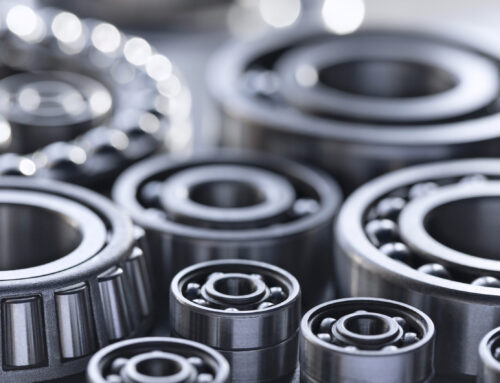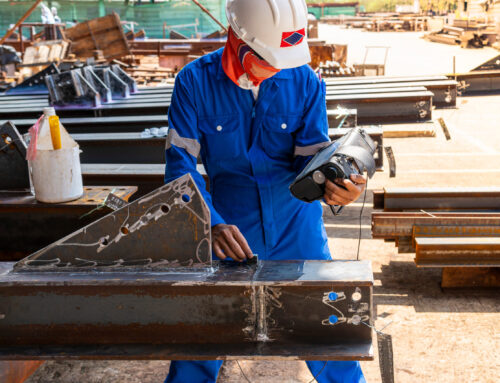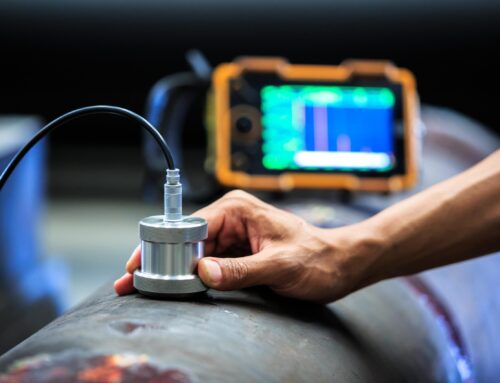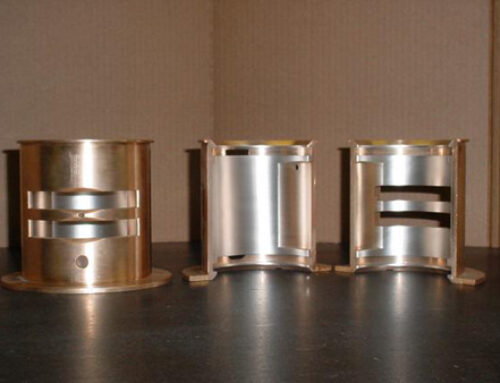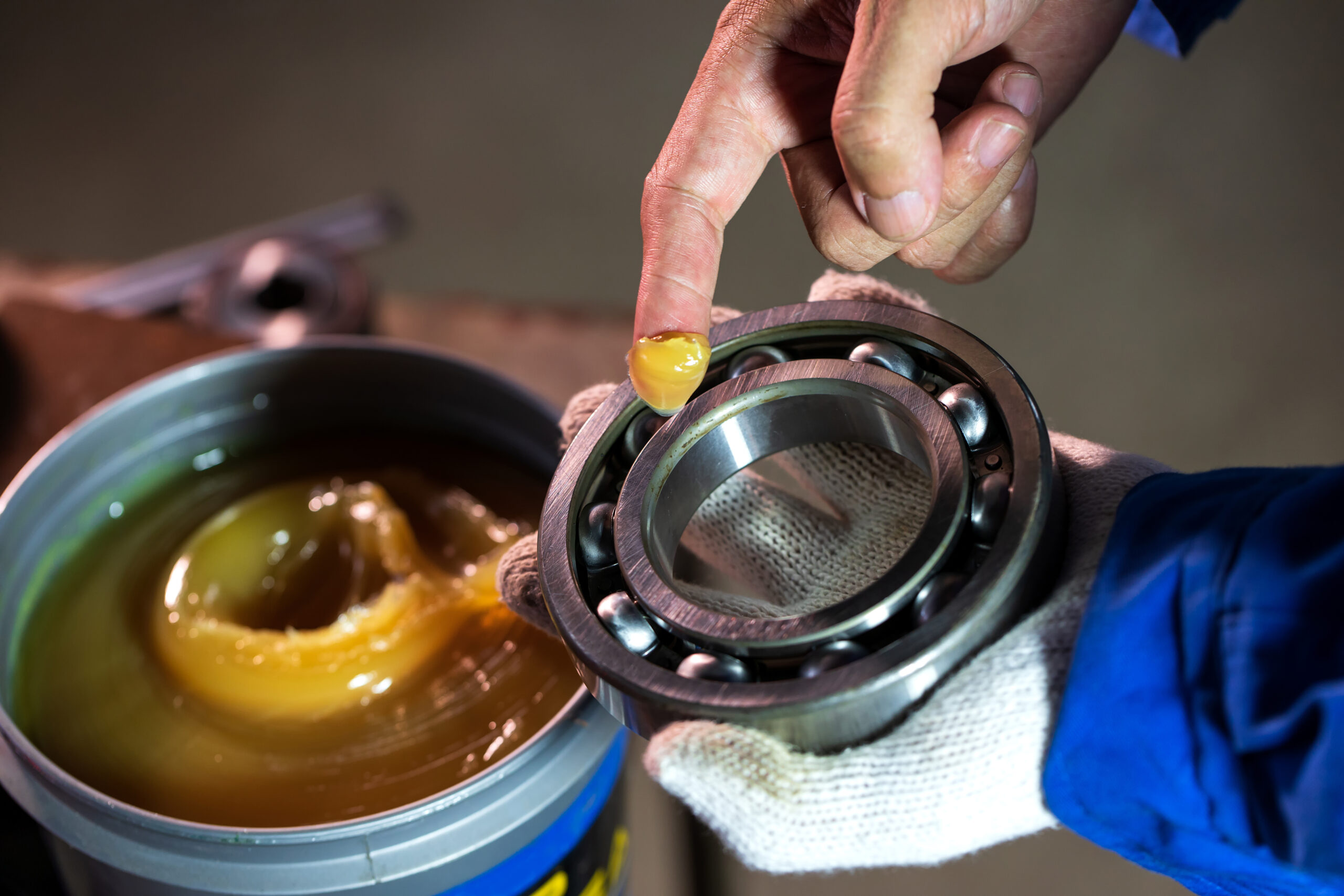
Pump bearing rebabbitting: sleeve clearances, lubrication, and when to rebabbitt vs. replace. If you run process-critical pumps, the health of your sleeve bearings dictates uptime, vibration levels, and energy efficiency. This guide explains practical clearance targets, proven lubrication choices, and a clear decision path for choosing between rebabbitting and replacement. You will also learn how Fusion Babbitting supports fast, reliable repairs that meet or exceed OEM expectations.
What pump sleeve bearings do and why they matter
Sleeve bearings in pumps support the shaft with a thin hydrodynamic oil film. Instead of rolling elements, they rely on a wedge of lubricant that forms as the shaft rotates. When clearances and lubrication are right, the Babbitt lining carries high loads with low friction, the shaft runs centered in the bearing, and vibration stays within limits. When clearances slip out of tolerance or lubrication fails, metal contact rises, temperatures climb, and the bearing can score, smear, or wipe. Pump bearing rebabbitting restores that precision surface so the pump can return to reliable service.
Clearances for pump sleeve bearings
Radial and diametral clearance basics
Radial clearance is the difference between the bearing radius and the shaft radius. Diametral clearance is twice the radial clearance. Too tight and the oil film cannot form, which creates heat and rapid wiping. Too loose and the rotor becomes unstable, causing vibration, noise, and higher wear. A common starting point is to set clearances based on shaft diameter and operating conditions. Many pump bearings target radial clearance in the range of one to two thousandths of an inch per inch of shaft diameter. Exact values vary by design, speed, load, and lubricant viscosity. Always confirm against the OEM specification, and when those values are not available, Fusion Babbitting can help reverse engineer a safe, durable clearance for your duty cycle.
Thermal growth and operational factors
Bearing and shaft growth change running clearances. Factors include metal temperature rise, ambient conditions, and oil viscosity. A pump that sees hot process fluid or high ambient heat needs extra attention because the shaft can grow at a different rate than the bearing shell. This is why your cold clearance target may not match the hot running clearance. Fusion Babbitting accounts for thermal growth by measuring material properties, reviewing your duty cycle, and selecting a clearance that maintains a stable oil film throughout start up, steady state, and transient events.
Surface finish, roundness, and alignment
A precision finish helps build a steady hydrodynamic film. Aim for a smooth, uniform bore finish and a shaft finish typically near 16 microinch Ra or better. Out-of-round bores, misalignment, and lobed surfaces push oil away from the loaded zone and create hot spots. During pump bearing rebabbitting, Fusion Babbitting machines bores back to proper geometry and verifies roundness and alignment. This attention to detail reduces vibration and extends bearing life.
How to measure bearing clearances
Several methods help verify clearances:
- Use a calibrated micrometer to measure the shaft journal diameter across several planes.
- Use a dial bore gauge to measure the bearing bore after machining and after final sizing.
- Check roundness and taper across 90-degree planes to ensure the bore is uniform.
- Record ambient temperature and component temperature at the time of measurement to factor thermal expansion.
- Blue the surfaces to check contact patterns if applicable during assembly checks.
Fusion Babbitting verifies clearances with precision inspection tools and documents results to support quality audits and maintenance records.
Lubrication for pump sleeve bearings
Oil ring and bath systems
Many pump bearings use oil rings that dip into a reservoir and carry oil up into the bearing. Oil level is critical. Too low and the ring starves the bearing. Too high and churning losses raise temperature and oxidize the oil. Verify that the oil level gauge is accurate and that the reservoir is clean. On startup, confirm ring motion is smooth and free from wobble.
Pressurized systems
High-power or high-speed pumps often rely on forced oil lubrication with filtration and cooling. These systems stabilize temperature, maintain clean oil, and support higher loads. Monitor supply pressure, return flow, and oil temperature. Set alarms to catch clogged filters or pump failures before bearing damage occurs.
Grease-lubricated sleeves
Some smaller or slower pumps use grease in sleeve bearings. In these cases the grease must be compatible with the base material and thickener should match temperature and speed. Overgreasing can cause churning and heat. Under-greasing can lead to dry starts and wiping. Follow manufacturer volume and interval guidelines and consider installing relief ports to avoid pressure buildup.
Choosing lubricant viscosity and additives
Viscosity determines film thickness. Too low and the film collapses. Too high and friction and heat increase. Many pump bearings run well on ISO VG 32 to 68 oil, but always check OEM guidance. For wet environments or frequent starts, consider an oil with robust antiwear and antioxidant packages. If water or process fluid can enter the housing, a demulsifying oil can help separate water in the reservoir. Fusion Babbitting can review your service conditions and recommend a lubricant strategy that protects your new or rebabbitted sleeve bearings.
Common lubrication failures and how to avoid them
- Contamination with water or process fluids. Improve seals, check venting, and test oil for water content.
- Dirty oil due to lack of filtration. Install or upgrade filters and set change-out intervals.
- Wrong viscosity. Match oil grade to speed, load, and temperature profile.
- Poor oil ring function. Verify ring size, surface finish, and alignment.
- Overheating in summer or during process upsets. Consider coolers or higher viscosity index oil.
When to choose pump bearing rebabbitting vs. replacement
Good candidates for rebabbitting
Rebabbitting restores the working surface while preserving the original shell or housing. It is ideal when the shell is structurally sound and dimensions can be recovered. It is often the fastest route back to service when OEM lead times are long or the bearing is obsolete. If the pump has a custom housing or a split shell with special oil grooves, pump bearing rebabbitting by Fusion Babbitting can replicate those features and return performance to spec.
When replacement is the better path
If the shell is cracked, severely worn, or distorted beyond recovery, a new bearing may be the safest choice. Severe corrosion, deep fretting at fits, or repeated bond failures can also point toward new manufacture. Fusion Babbitting offers new custom manufacturing and reverse engineering when OEM parts are unavailable, and can fabricate to tight tolerances for a drop-in fit.
Cost, lead time, and risk factors
Rebabbitting often lowers cost and turnaround time compared to new parts, especially for large or legacy bearings. Consider downtime costs, availability of spares, and the consequence of a repeat failure. If you need a rapid turnaround, Fusion Babbitting provides 24-hour emergency services that minimize production loss while delivering dependable quality. If a pump is being upgraded for a higher duty, a new bearing design might be justified. Fusion Babbitting can advise on both options so you can choose with confidence.
A simple decision checklist
- Inspect the shell for cracks, distortion, and pitting. If severe, consider replacement.
- Evaluate bond condition of the existing Babbitt. If debonded or heavily wiped only, rebabbitting is likely viable.
- Confirm fits to the housing and shaft. If fits are recoverable by machining or spray, rebabbitting is still viable.
- Check availability and lead time for new OEM parts. If long or obsolete, prefer pump bearing rebabbitting.
- Assess operational changes. If load, speed, or temperature are increasing, consult engineering to confirm suitability.
How Fusion Babbitting performs pump bearing rebabbitting
Inspection and reverse engineering
Fusion Babbitting Co., Inc., based in Milwaukee, WI, starts with a thorough inspection. Technicians document critical dimensions, evaluate the bond, and identify wear patterns. When drawings are not available, reverse engineering creates a precise digital model and manufacturing route. This is essential when replicating oil grooves, reliefs, and chamfers that influence film formation and cooling.
Centrifugal casting for a strong bond
For pump bearing rebabbitting, Fusion Babbitting uses centrifugal casting with certified Babbitt alloys. The process cleans and tins the base metal, then spins molten Babbitt to achieve uniform thickness and a high-integrity bond. Centrifugal force drives out porosity and helps prevent inclusions. After casting, technicians perform bond verification, including nondestructive examination where appropriate.
Finish machining, grooving, and quality control
Once bonded, the bearing is machined to final diameter, roundness, and finish. Fusion Babbitting recreates oil grooves and lubrication features to OEM or engineered specifications. Tolerances for bore size, roundness, and surface finish are verified and recorded. When housings or journals are worn, Arc Flame Spray Application can rebuild base dimensions, which are then machined back to spec. The result is a bearing ready for service with the clearance and geometry your pump requires.
Capacity, fabrication, and emergency support
Fusion Babbitting handles repair, rebuilding, and new manufacturing for components up to 120 inches in diameter and length. The team supports electric motors, pumps, turbines, hydro power units, and more. When downtime costs are critical, 24-hour emergency service accelerates inspection, rebabbitting, and shipment. Nationwide logistics support helps you keep outages short and predictable.
Extending the life of rebabbitted pump bearings
Installation best practices
- Clean all fits and check housing bore size and roundness. Correct with machining or spray weld where needed.
- Verify shaft journal finish and hardness. Polish or regrind to achieve the target Ra and remove ridges.
- Align the bearing to the shaft centerline. Confirm vertical and horizontal alignment before tightening caps.
- Lubricate during assembly and pre-lube before first start to avoid dry friction.
Controlled startup and break-in
On first run, monitor temperature, vibration, and oil flow. Bring the pump up to speed gradually if possible and look for stable readings. A small temperature rise is normal as the film forms, but a rapid climb suggests misalignment, low oil, or tight clearance. Set baseline data for future comparison and keep a log for the first week of operation.
Monitoring and predictive maintenance
- Vibration analysis to track bearing condition and detect rubs or instability.
- Oil analysis for viscosity change, wear metals, water, and particle count.
- Thermal imaging to spot localized hot zones that may indicate restricted flow or misalignment.
- Regular checks of oil level, ring condition, seals, and breathers.
With consistent monitoring, small issues can be corrected before they cause damage. Fusion Babbitting can review data trends and suggest adjustments to clearances or lubrication as your process changes.
Industries and equipment Fusion Babbitting supports
Fusion Babbitting serves a wide range of facilities that depend on reliable pumps and rotating machinery. The team has decades of experience in environments where uptime and safety matter most.
- Aluminum mills, mines, and steel mills
- Cement and chemical plants
- Fossil and nuclear plants
- Hydro and pump storage facilities
- Marine repair and shipyards
- Paper mills and crushed stone producers
- Motor repair shops and OEMs
Common applications include electric motors, hydro power systems, pumps, and turbines. Whether you need emergency pump bearing rebabbitting or a new custom bearing package, Fusion Babbitting delivers repeatable quality and responsive service.
Frequently asked questions about pump bearing rebabbitting
How long does rebabbitting take?
Lead time depends on size, condition, and any reverse engineering needs. Many jobs turn around in days, not weeks. Fusion Babbitting also offers 24-hour emergency service for critical outages.
What if my bearing is obsolete?
Reverse engineering and new manufacturing can recreate obsolete bearings. Fusion Babbitting documents all features and produces detailed drawings for future support.
Will a rebabbitted bearing last as long as a new one?
Yes, when properly cast, machined, and lubricated, a rebabbitted bearing performs like new. Clearances, finish, and bond integrity are the keys to long life. Fusion Babbitting uses centrifugal casting and rigorous QC to meet or exceed OEM expectations.
Can you repair damaged housings or shafts?
Yes. Arc Flame Spray Application can restore worn housings or shaft fits. After spray, parts are machined back to standard sizes, allowing proper fits and clearances.
What information helps speed the process?
Provide shaft diameter, bearing dimensions, material info, operating speed, load estimates, lubricant type, and any OEM drawings. Photos of damage and service conditions also help. Fusion Babbitting can gather missing data through inspection and measurement.
About Fusion Babbitting
Fusion Babbitting Co., Inc. has specialized in Babbitt bearing services since 1988. Located at 4540 W. Burnham St. in Milwaukee, WI, the team offers repair, rebabbitting, rebuilding, reverse engineering, and new manufacturing. Services include centrifugal casting with certified Babbitt alloys, Arc Flame Spray Application, general fabrication and machining up to 120 inches, and quality systems that deliver consistent, verified results. With more than 40 years of combined expertise, Fusion Babbitting focuses on reliability, performance, and fast turnaround for customers nationwide.
Call for expert help with pump bearing rebabbitting
If you need guidance on clearances, lubrication, or whether to rebabbitt or replace, talk to Fusion Babbitting. The team will assess your application, explain options, and recommend a plan that balances reliability, cost, and lead time. Get in touch for emergency support or to schedule a proactive rebuild before your next outage.
Contact Fusion Babbitting Co., Inc. Address: 4540 W. Burnham St., Milwaukee, WI 53219 Phone: 414.645.5800 Toll-Free: 800.613.5118 Email: sales@fusionbabbitting.com
From aluminum mills and power plants to mines and marine repair, Fusion Babbitting keeps pumps and rotating equipment running. When quality, speed, and confidence matter, choose a partner that knows pump bearing rebabbitting from the inside out.

